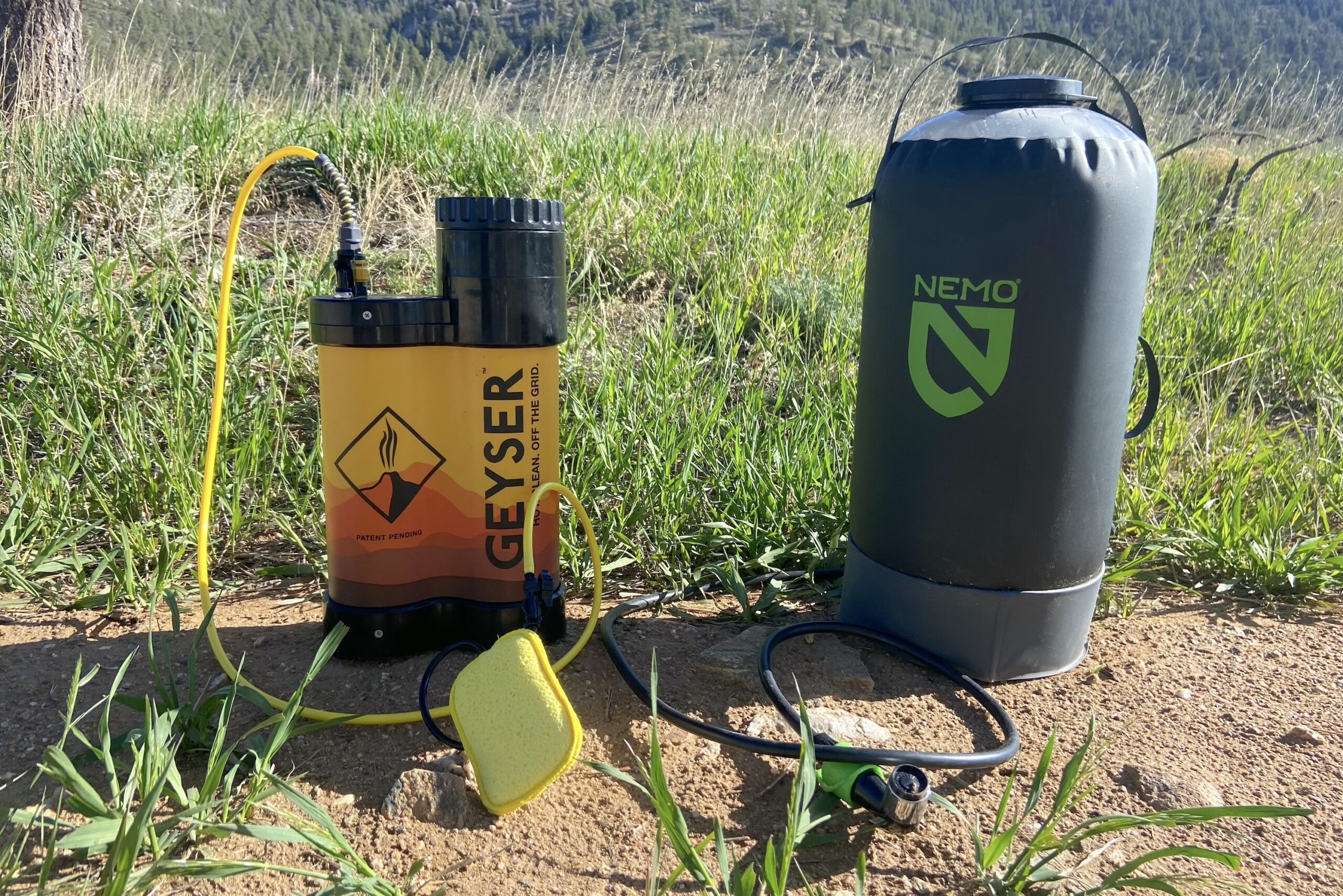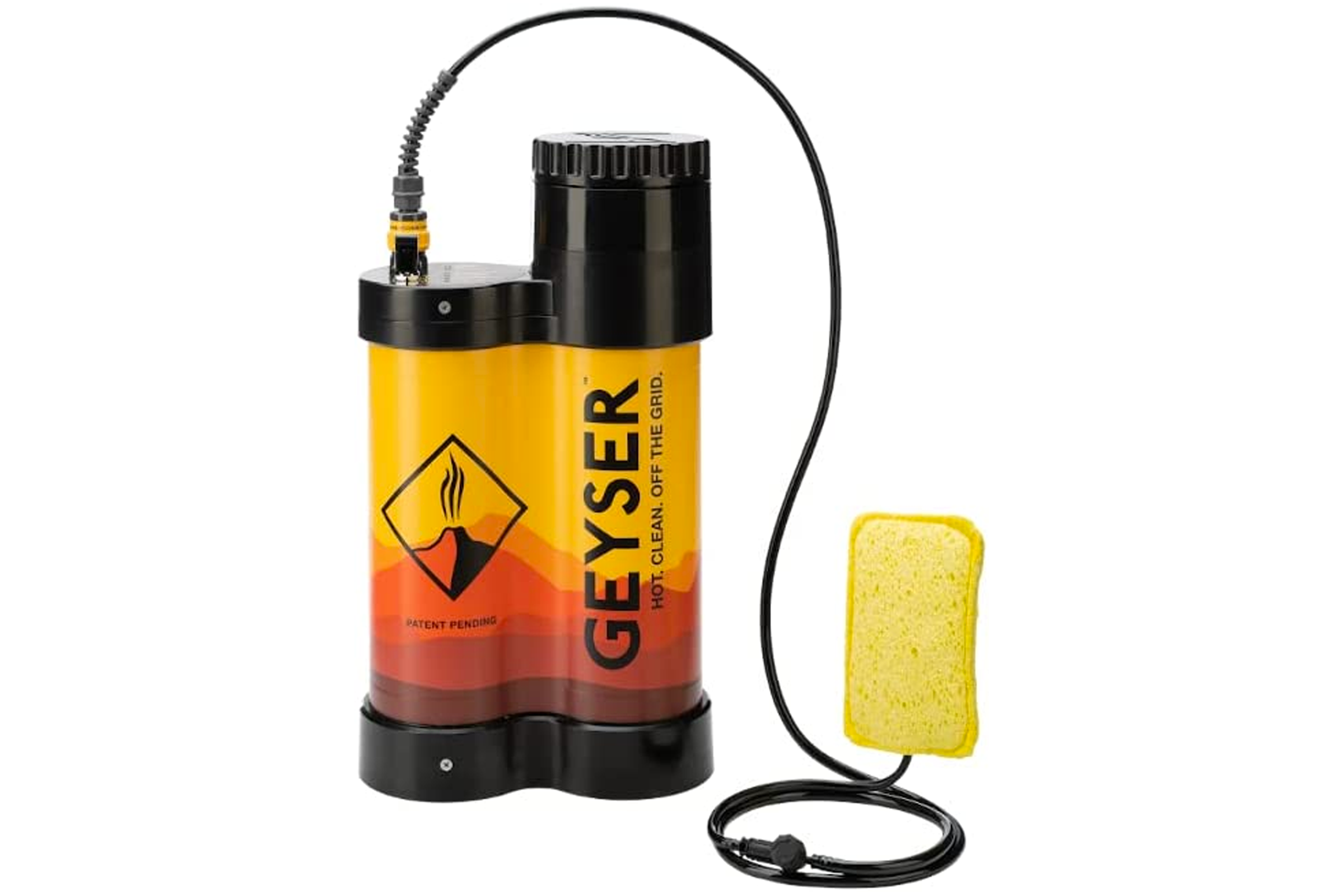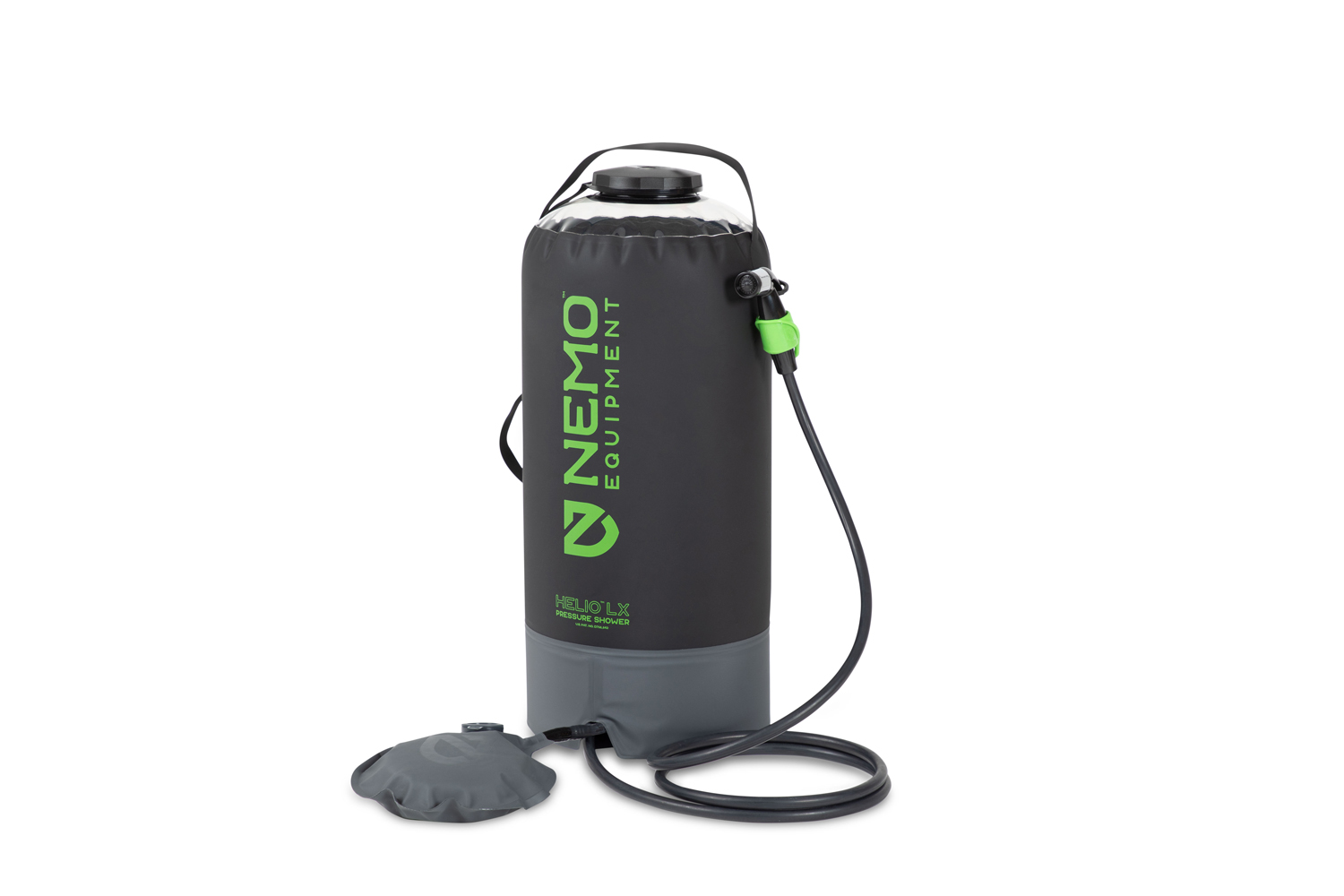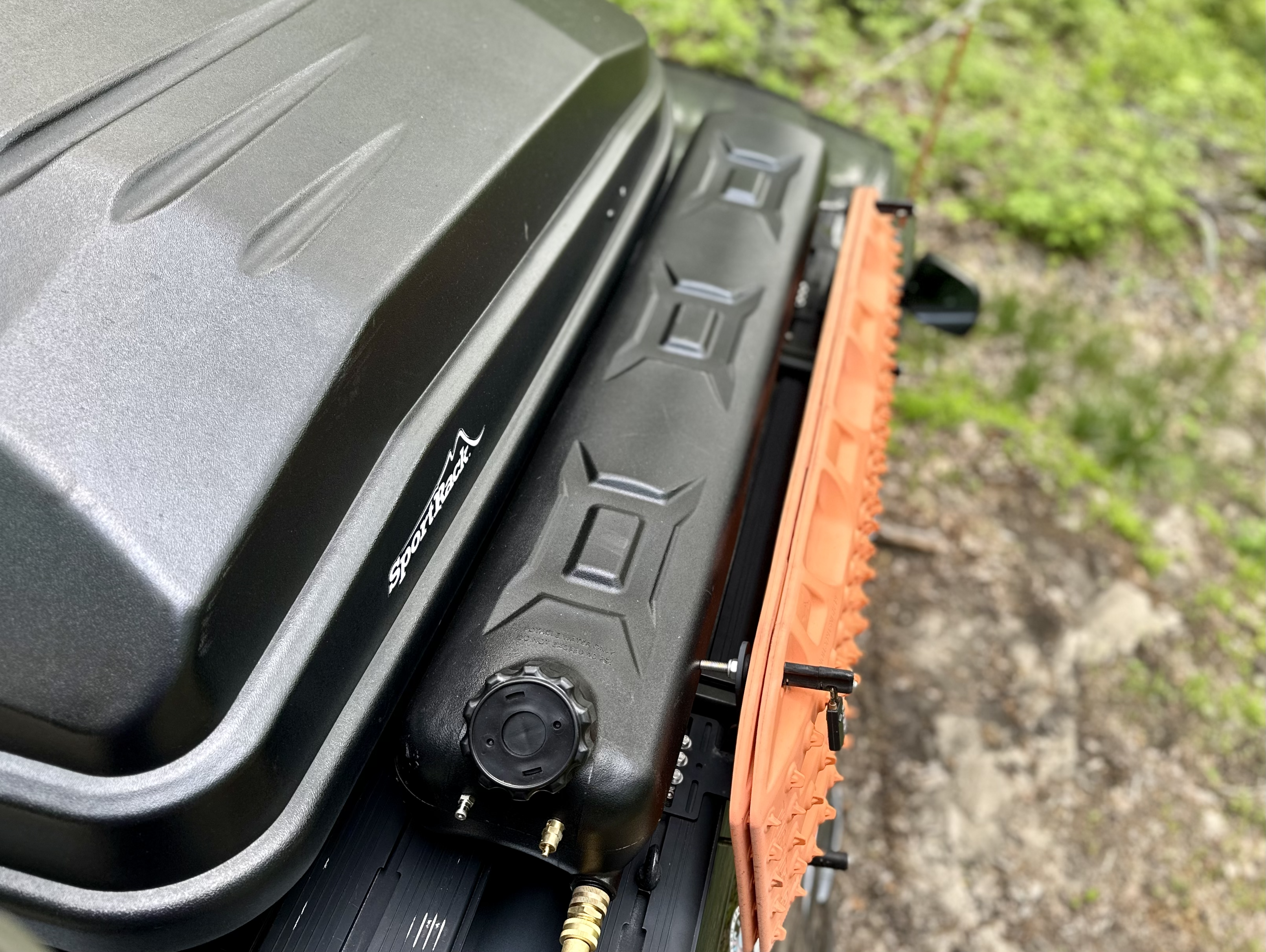This spring, I’ve been preparing to move into a tiny truck camper. The decision came with an abundance of back-and-forths over a lot of nitty-gritty details. Moving into such a small space presents a lot of clear compromises.
My camper is on a truck with a 6-foot bed, so space is very limited. Quickly, I realized that any sort of water tank system would be too heavy and cumbersome for my setup. So, I started to look at other options for doing dishes, taking showers, and cleaning gear.
The Geyser and NEMO Shower Systems are some of the most popular van life shower systems out there. Knowing this, I set out to compare the two to see what would work best for my rig.
It’s worth saying that neither shower system offers a full-blown “at-home” shower or sink experience. If you have a tricked-out Sprinter van or RV with a large water tank and plenty of power to run a traditional RV shower system, these models might be a bit too pared down for your taste.
In short: These shower systems shine in the smaller rigs and Subaru buildouts, or you can throw them in your 4×4 for the quick post-surf or mountain bike rinse. The Geyser ultimately won me over, but both the Geyser and NEMO Helio LX have major pros, and a couple of differences for usage outdoors.
Geyser vs. Nemo Helio Shower System Head-to-Head Review
- Capacity: 0.8 gal. (3 L)
- Power source: 12V DC power, comes with 15-ft. extension cord
- Flow: 1 minute at highest flow rate, 15 minutes of water at lowest flow rate
- Built-in heater: Yes (model available without heater)
- Max temp: Operational up to 101 deg. F
Pros
- Can be used inside a van with a sink and/or wash basin
- Heats water using little power
- Saves water
- Takes up less space
- Longer run time/flow rate
Cons
- Rinsing your body, and especially dishes, can be cumbersome without changing or removing the scrub
- Changing the water pressure is difficult with one hand
- Higher price point
- For tough grime, using a hardier sponge with the scrub might be necessary
- Capacity: 5.8 gal. (22 L) or 3 gal. (11 L)
- Power source: Manual, w/a foot pump
- Flow: 7-10 mi. spray
- Pressure: Fully pressurizes in 45 seconds
- Setup: Sits on ground or hangs
- Built-in heater: No
- Max temp: N/A
Pros
- Strong spray pressure
- Large water capacity
- Durable
- Affordable
- Works with nonpotable water
Cons
- Larger and cumbersome to carry and move from water source
- Must be used outside
Testing the Shower Systems in the Field
Both of these showers are impressive, though they each offer different features and some drawbacks. The differences are important to consider if you’re choosing a setup for just on-and-off adventures, versus full-time van life like me.
Geyser Shower System: Best Heated System, Conserves Water Too
The Geyser Shower System has a learning curve. My friend accurately calls it an “astronaut shower.” It lands somewhere between a sponge bath and a camp shower, and it pumps water through interchangeable scrub heads (extras sold separately).
Ultimately, washing long hair and your body isn’t luxurious, but it gets the job done. Mastering the flow rate to make your water last the longest is tricky, but I found that a 5- to 10-minute shower (with a short rinse with the hose at the end) is very feasible on one tank.

The Geyser with Heater is unique because it allows you to take a hot shower via a 12V port. The heating isn’t instantaneous (about 30 minutes depending on initial water temp), but the system does produce a hot shower while pulling a limited amount of power.
If you want a hot shower quickly, you can mix boiling water with cool water, and the Geyser will adjust the water temperature until it is at a safe, warm level. It also has a safety shutoff if the water temp is ever unsafe or too hot.
Plus, the shower maintains its heat. So, if you have some power to spare overnight, you can leave your shower plugged in to have some warm water in the morning.
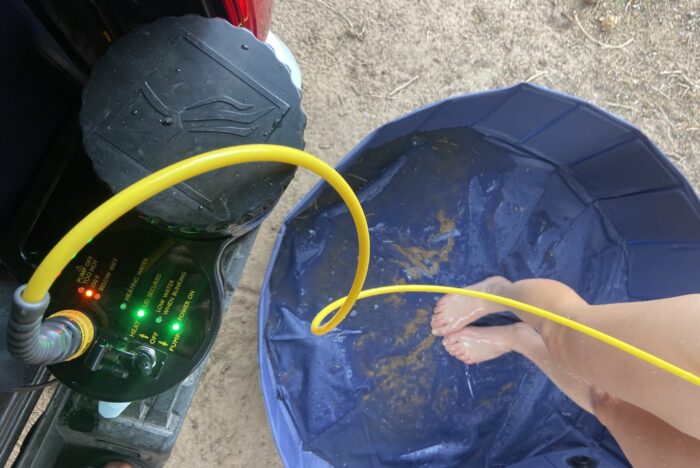
While the Geyser shower system is unique since it has a built-in heater, that brings some drawbacks. For one, the Geyser plus Heater unit and Geyser traditional model require a power source, specifically a car outlet. So, you either have to run your vehicle or use an external battery or power station (I used my Jackery Explorer 1500) to power the shower.
That being said, I was impressed with the low overall power usage of the Geyser. I did a large load of dishes without heat and my battery didn’t drop a single percentage point. With heat, the system pulls more significant amounts of power, but is manageable.
I found that after a full night of heating and maintaining a core temperature of 100 degrees, the shower pulled around 40% of my battery’s power. While a large chunk, that’s for about 8+ hours of use, which is pretty good.

For a 10-minute shower with heat, my battery’s charge dropped 4% after heating and using the shower. It took 35-40 minutes to heat the shower from a lukewarm temperature to 100 degrees. I was able to use a low-flow setting for initial scrubbing, medium flow for washing my long hair, and ended my shower using the hose to rinse. I felt clean and content, and the heated water was a great bonus. Pro tip: If you are rinsing off with a wetsuit or rash guard on, stuff the hot sponge in your top for a couple of seconds to warm up quickly.
NEMO Helio LX Shower: Better for Outdoor-Only Uses, Gear Cleaning

In comparison, the NEMO Helio LX Portable High Pressure Shower is a bit more traditional, but it packs a punch. For one, the shower doesn’t require any power, so it’s more widely usable and portable.
I found the Helio LX is geared toward a fully outdoor kitchen and shower setup. That is, don’t plan to take a stealth shower inside your van or do your dishes at your tiny sink with this shower bag.
To operate the shower requires using a foot pump, which creates steady and impressive water pressure, akin to what you might find from a lower setting on your garden hose. Because of this, the shower itself uses a lot more water than the Geyser.
The shower bag is durable and sturdy (I dragged it up a jagged river bank without any punctures) and because it is black, the shower bag naturally picks up heat. You can also directly add hot water to the system from your camp stove, although the large water capacity means you’ll have to boil a lot more than you would for the Geyser (again, this system uses more water).

On the other hand, while the Geyser system requires potable water to not damage its pump, the Helio LX works fine with river water and the like.
Overall, the Helio LX is a remarkable upgrade from traditional “shower bags,” which you have to hang and that offer limited capacity and fluctuating water pressure. It is a great option for quick rinse-offs from the trunk of your car.
I drove long, bumpy distances with the shower bag in my camper, and the shower stayed sealed with no leaks. Pumping the shower bag is easy, and while the pressure lasts for a while until you need to re-pump, the shower’s design makes it easy to keep the water pressure going and pump with your foot.

I washed my entire muddy mountain bike in around 3.5 minutes and used about one-fourth of the water in the tank (about 4-5 L). The shower also has a convenient pressure tab, so you can hang the nozzle overhead and take a hands-free shower. Pro tip: Bring a ski strap to secure the nozzle to a tree branch and you’re good to go!
Geyser Shower vs. Nemo Helio System: The Verdict

Both shower systems are great additions to anyone’s setup. Ultimately, the Geyser will be my go-to for long trips in my camper where stealth camping, staying warm, conserving water, and indoor dishes/showering will be more of a necessity. The added feature of a heated shower or faucet (while conserving power and water) is awesome.
Although, it’s hard to beat the 10-minute shower and continuous running flow that the Helio LX provides. So for less cumbersome rinses, warm weather, and car camping with friends, the Helio LX will come along for the ride.
Finally, there’s the price difference. Obviously, the Geyser system, which requires a power source, has a fancy water level sensor, and the addition of heat bumps up the price — $350 MSRP, compared to the NEMO Helio LX at $160 MSRP. The Geyser Shower without the heater will run you $280. But if you are splurging for this system, we recommend the heated one.
- Get the Geyser with Heater System if you plan to do dishes inside your rig, want to heat water without using a stove, need to conserve water, and/or want to take showers either inside or outside your van. Or, if you need a smaller system to save space.
- Get the NEMO Helio LX if you want a portable, quick, and easy-rinse system without needing a power source — and, if you plan to wash gear, yourself, and dishes completely outside of your rig.
